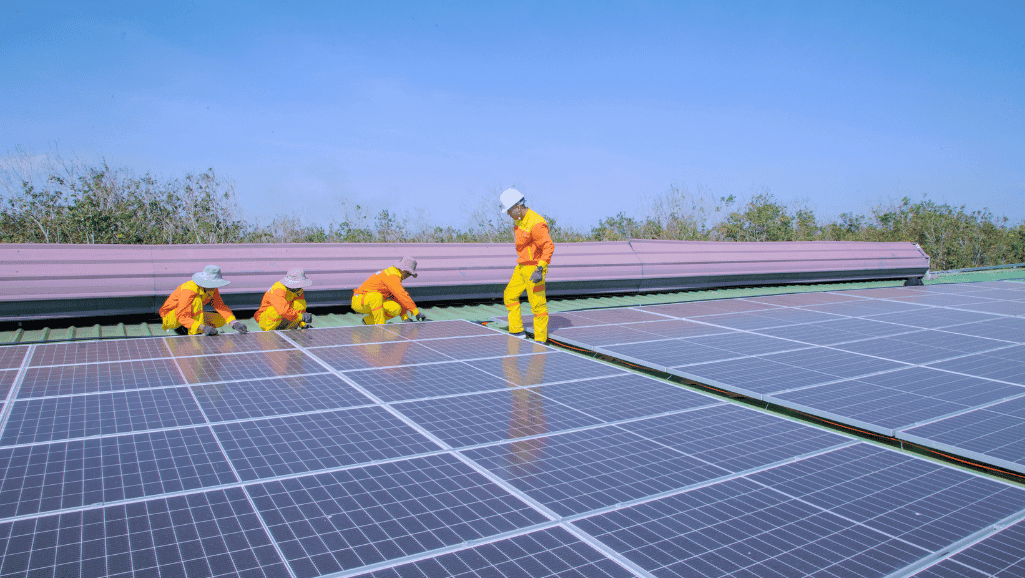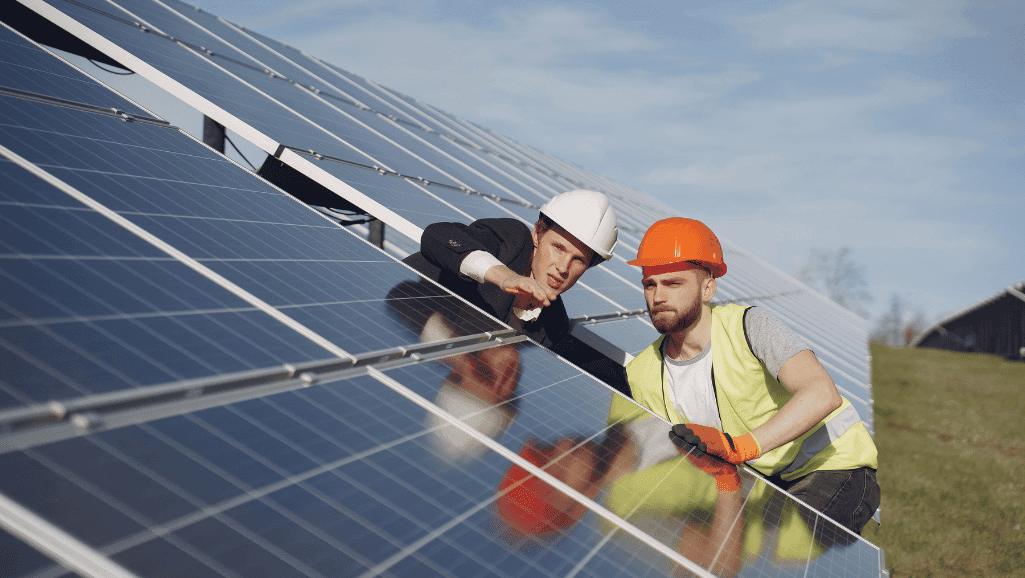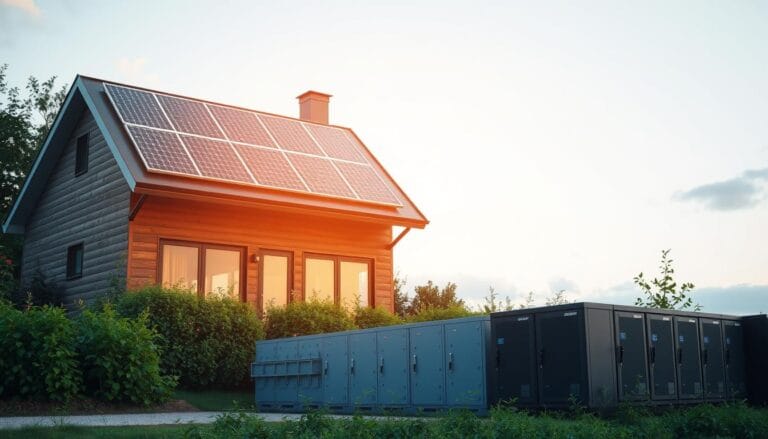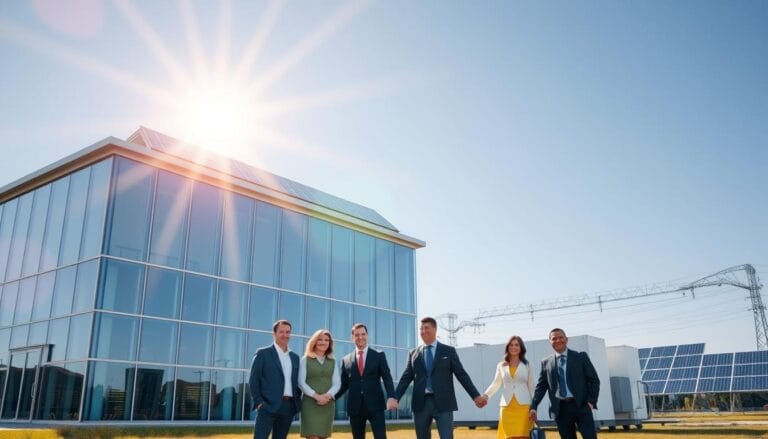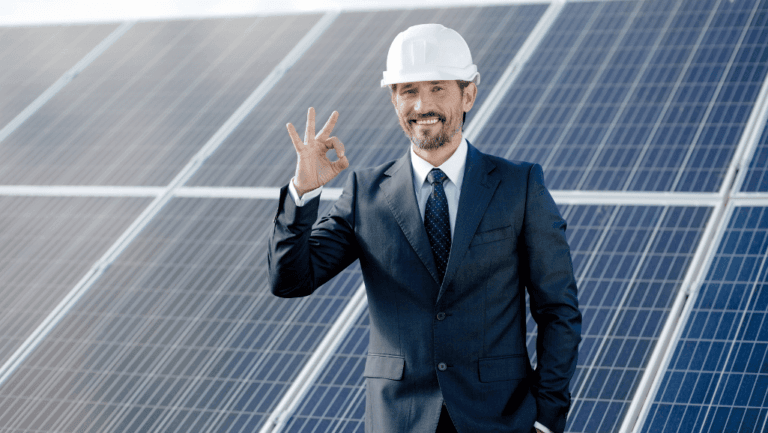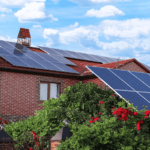Discover a future-proof investment that offers more than just energy savings. Commercial solar installation not only equips businesses with sustainable power generation, but it also lays the groundwork for a greener corporate identity. With expensive power rates on the rise, solar energy emerges as a compelling alternative, promising substantial reduction in both environmental footprint and operational costs.
Aided by federal incentives and the growing demand for clean energy, businesses of various scales are increasingly turning to commercial solar solutions. Implementing these systems does more than reduce costs; it amplifies your brand’s commitment to renewable energy solutions—important in an era where sustainability measures are a key business determinant.
Key Takeaways
- Strategically lower your utility expenses while contributing to cleaner energy initiatives.
- Unlock financial gains with federal tax credits and incentives to maximize ROI.
- Enhance your brand’s value and appeal to eco-conscious consumers and employees.
- Support the growth of the local economy through job creation and innovation in renewable energy.
- Invest in energy independence to shield your business from unpredictable utility rate hikes.
Experience the double-win of being an environmentally responsible brand while saving on costs.
- Enjoy the adaptability of solar solutions that cater to businesses of all sizes and energy needs.
Understanding Commercial Solar Installation Benefits
The shift towards solar panel systems in the commercial sector is increasingly recognized not just as an environmentally sound decision, but also a significantly beneficial financial move. By adopting photovoltaic installations, businesses are setting themselves on a path to considerable energy cost savings while enhancing their sustainability credentials.
Reducing Operational Costs with Solar Power
Commercial solar installations are pivotal in decreasing ongoing energy expenses. These systems generate electricity autonomically, eliminating the high costs associated with traditional fossil fuels. Solar panels are not only cost-effective due to their low maintenance needs but also provide reliable energy outputs that stabilize operational budgets, crucial for any business’s financial health. As energy costs rise, the relative savings afforded by solar power increase, driving a reduction in overall operational expenses.
Navigating Financial Incentives for Solar Investment
Governments offer numerous solar incentives and tax benefits, making solar installations more appealing to businesses financially. The significant solar tax credit, known as the Investment Tax Credit (ITC), allows companies to deduct a portion of their solar system cost from their federal tax obligations. Additionally, options like the Modified Accelerated Cost-Recovery System (MACRS) enable businesses to accelerate depreciation on their solar investments, enhancing the fiscal attractiveness of switching to renewable energy.
Projected Savings Over Time for Businesses
The long-term financial benefits of photovoltaic installations cannot be overstated. With the declining costs of solar technology and the extension of the solar ITC, systems installed now guarantee even greater returns on investment over time. Beyond direct financial gains, businesses benefit indirectly through increased property values and potential revenue from selling surplus energy back to the grid.
Furthermore, a consistent decrease in energy expenditures year-over-year helps businesses reallocate funds that would have been spent on utility bills toward other strategic areas such as expansion or enhancing productivity. This financial flexibility is a clear competitive advantage in today’s market. As global consumer trends increasingly favor environmentally conscious companies, investing in solar power can also translate to increased consumer loyalty and brand strengthening.
| Year | Energy Cost Saving | Tax Credit Savings | Total Savings |
|---|---|---|---|
| Year 1 | $5,000 | $2,000 | $7,000 |
| Year 2 | $5,500 | $2,000 | $7,500 |
| Year 3 | $6,000 | $2,000 | $8,000 |
| Year 4 | $6,500 | $2,000 | $8,500 |
| Year 5 | $7,000 | $0 | $7,000 |
It’s clear that solar panel systems offer not just an eco-friendly energy solution but significant economic benefits for businesses. By leveraging solar incentives and harnessing the inherent efficiencies of photovoltaic installations, companies gain a competitive edge while contributing positively to global sustainability goals.
Exploring Financial Incentives and Tax Credits
For businesses contemplating commercial solar installations, understanding the array of solar investment incentives and tax credits is crucial. These financial measures are designed to make solar projects more affordable and financially attractive.
One of the primary incentives is the Investment Tax Credit (ITC), which currently allows businesses to deduct 30% of the cost of installing a solar energy system from their federal taxes. This substantial tax credit was reinforced by Congress to remain at 30% for systems installed through 2032, reflecting the government’s support for renewable energy adoption.
Another compelling incentive is the Production Tax Credit (PTC), which benefits businesses based on the amount of electricity produced. This credit offers a per kilowatt-hour financial benefit for solar systems during the first ten years of operation, incentivizing not only installation but also the efficient operation of solar systems.
Moreover, the Modified Accelerated Cost Recovery System (MACRS) allows for the accelerated depreciation of solar energy investments. Businesses can depreciate the value of the solar system over five years, leading to significant deductions in the taxable income during this period.
Additionally, combining the ITC with 100% bonus depreciation under the Tax Cuts and Jobs Act enables businesses to recover costs quickly—often within five years, optimizing the return on investment and easing the financial burden upfront.
The concept of net metering further underscores the cost-efficiency of investing in solar. This policy allows businesses to receive utility bill credits for the excess energy their solar systems generate and feed back into the grid. This not only reduces energy costs but also enhances the system’s overall value proposition by converting surplus generation into tangible financial savings.
These incentives collectively facilitate a more manageable initial investment and accelerate the path to cost recovery, making solar installations a financially viable and attractive proposition for businesses.
| Incentive | Details | Impact |
|---|---|---|
| Investment Tax Credit (ITC) | 30% tax credit for systems installed by 2032 | Reduces upfront cost significantly |
| Production Tax Credit (PTC) | Tax credit based on electricity production for ten years | Encourages efficient long-term operation |
| MACRS + Bonus Depreciation | Accelerated depreciation over five years + potential 100% bonus depreciation | Fast-tracks cost recovery, reducing payback period |
| Net Metering | Credits for excess energy fed back into the grid | Reduces ongoing utility costs, increases ROI |
Understanding these incentives is instrumental for any business considering a shift to solar power, aligning long-term sustainability goals with immediate financial benefits and strategic fiscal planning.
The Impacts of Commercial Solar Installation on Brand Image
The decision to invest in commercial solar energy systems extends far beyond the immediate financial benefits, significantly impacting a company’s brand image. Aligning with corporate social responsibility and enhancing the perception as a sustainable brand are just the beginnings of this transition.
Recent trends indicate a substantial shift in consumer demand for sustainability, with studies showing that 81% of global consumers believe strongly in corporate roles in environmental improvement. By adopting solar panels, businesses not only address this demand but also position themselves as forward-thinking, environmentally responsible leaders.
Building a Sustainable Brand Reputation
Integrating green energy projects like solar installations signal a company’s commitment to sustainable operations. Environmentally conscious actions such as these resonate deeply with modern consumers and potential employees, nearly two-thirds of whom are willing to pay premium prices for products and services from sustainable brands. Companies can leverage this by showcasing their reductions in CO2 emissions and water savings.
Meeting Consumer Demand for Green Practices
Businesses that actively share details about their annual savings of 20 tons of CO2 and 3,000 gallons of water place themselves at a competitive advantage. This transparency not only supports corporate social responsibility but also caters to the rising consumer demand for sustainability. Such strategic positioning not only enhances brand appeal but also fosters loyalty among environmentally conscious consumers and attracts quality talent, with 64% of potential employees considering a company’s environmental commitments before accepting job offers.
Moreover, the media coverage that often accompanies significant investments in sustainable practices, like solar installations, serves to boost brand visibility and strengthen market position, potentially leading to long-term profitability enhancements and substantial cost efficiencies. A typical business might recoup their solar system investments within 5 to 7 years while saving substantially on energy costs, which can fortify the appeal of adopting renewable technologies.
Ultimately, the implications of going solar stretch far and wide, influencing not just the balance sheets but also how businesses are perceived in the public eyes, making commercial solar solutions a compelling strategy for modern enterprises aiming to meet the new standards of corporate responsibility and consumer expectations.
Maximizing ROI from Solar Panel Systems
In today’s economic environment, return on investment (ROI) is a critical metric for any business operation, particularly when it comes to infrastructure investments. Implementing commercial solar arrays is increasingly recognized not just as an environmentally conscious decision, but a financially savvy one due to significant energy cost savings and long-term investment benefits. Here, we explore how these systems provide economic advantages while promoting sustainability.
Commercial solar installations offer a dual benefit: immediate reductions in energy expenses and an increase in property values. Studies highlight the enhanced market value of properties equipped with solar panels, asserting an advantage in both leasing and resale markets. The long lifespan, often exceeding 25 years, ensures extended periods of reduced energy costs, amplifying the ROI substantially.
| Benefit | Description | Financial Impact |
|---|---|---|
| Energy Savings | Reduction in dependency on grid power, use of free solar electricity. | Direct savings on monthly energy bills. |
| Tax Incentives | Eligibility for federal and state tax credits, rebates, and grants. | Lower initial installation costs and faster payback period. |
| Property Value Increase | Higher property valuation for solar-integrated buildings. | Potential higher rents and sale prices. |
| Brand Image | Enhancement of brand reputation through sustainable practices. | Attraction of eco-conscious customers and potentially higher customer retention. |
The financial framework for solar investments includes numerous incentives, like federal tax credits, which cover 30% of the installation cost, decreasing annually until 2035. Additionally, many states offer perks such as property tax exemptions and sales tax waivers on solar equipment. These financial support systems not only lower upfront costs but also accelerate the breakeven point, making solar a lucrative long-term investment.
Maintenance plays a crucial role in ensuring the optimal performance of commercial solar arrays. Regular upkeep helps prevent efficiency losses, thereby maximizing energy cost savings and sustaining the ROI. Tasks include routine panel cleaning and damage checks, which are vital for long-term operational success.
Ultimately, the decision to invest in solar technology should be viewed through the lens of long-term financial planning, where the initial expenditures are offset by substantial economic returns and long-term investment benefits. These benefits are not just limited to financial gains but also contribute significantly to sustainability goals, aligning with global efforts to promote renewable energy adoption as detailed at Solar Powers World.
Tailoring Solar Solutions for Different Business Sizes
As more businesses and property owners lean towards commercial solar for different businesses, understanding how solar solutions can be adapted to their unique needs is critical. From small startups to large-scale industrial plants, the demand for custom photovoltaic systems has surged due to their high efficiency and the financial advantages they offer.
Customized Photovoltaic Installations
Customization in solar solutions is key to maximizing the cost-efficiency and operational benefits for any business. Companies like SolarTech have excelled in providing bespoke solar installations that align perfectly with the spatial, architectural, and energy production needs of various industries, including retail, public sectors, and manufacturing units. Notably, a Tennessee-based manufacturing company saw its energy bills drop by 70% after installing a tailored 50KW solar system, highlighting the impactful returns from such bespoke installations.
Moreover, these custom systems allow properties, even in complex layouts, to achieve energy self-sufficiency, thereby increasing their value and appeal. Properties with custom solar systems have also exhibited a 4% higher occupancy rate, underlining the tangible benefits of personalized solar solutions.
Scalable Solar Designs for Growing Companies
As businesses grow, so do their operational sites and energy needs. Scalable solar solutions address this dynamic by allowing expansions without compromising on energy efficiency or incurring significant new costs. This adaptability is crucial for businesses looking to future-proof their operations against rising utility rates while maintaining eco-friendly practices.
Businesses can commence with modest installations, expanding as they scale up operations. Such scalability not only ensures a better ROI but also enhances the commercial property’s attractiveness to eco-conscious tenants and investors.
With the lifespan of solar systems stretching up to 30 years and numerous financing options like loans and PPAs available, companies can transition to solar power with reduced upfront costs and manageable repayment terms. Not to underestimate, the protective canopies provided by these installations in agricultural settings also underline the versatility and broad applicability of solar power across different sectors.
Ultimately, whether it’s through direct energy cost savings, enhanced property values, or tax benefits, leveraging custom photovoltaic systems and scalable solar solutions ensures that businesses of all sizes and sectors can achieve not just sustainability, but a significant competitive edge in today’s market.
Solar Power as a Catalyst for Employee and Customer Engagement
Incorporating solar power into business operations not only contributes to a cleaner environment but also significantly boosts both employee engagement and customer loyalty. By demonstrating a commitment to sustainability, businesses can foster a strong sense of community and shared values among employees and customers alike. Harnessing clean energy infrastructure serves as a robust foundation for building these relationships.
Employee engagement is particularly impacted by the adoption of solar power. Employees take pride in working for a company that cares about its environmental impact, which can greatly enhance their satisfaction and retention levels. This alignment of personal and corporate values is crucial in attracting top talent who are eager to contribute to meaningful, impactful work.
Similarly, customer loyalty strengthens when consumers see a company making genuine efforts to reduce their carbon footprint. Today’s consumers are increasingly making purchasing decisions based on the environmental actions of companies. Solar energy initiatives are a clear indication that a business is future-focused and committed to sustainability, qualities that resonate strongly with eco-conscious consumers.
The integration of clean energy infrastructure not only positions a company as a leader in sustainable practices but also shows its proactive stance in community and environmental responsibility. This is essential in cultivating a positive public image and foster community goodwill, which directly reflects on customer perceptions and interactions.
| Benefits | Impact |
|---|---|
| Increased Employee Morale and Retention | Enhanced mental wellbeing and a reduced turnover rate due to a greater sense of purpose and pride in the company’s environmental efforts. |
| Boost in Consumer Trust | Companies that embrace solar energy often see a rise in trust from customers, building stronger brand loyalty. |
| Enhanced Public Image | Being recognized as an environmentally responsible company helps improve public relations and attracts positive media attention. |
| Community Engagement and Development | Local community involvement increases through events and initiatives associated with the solar energy projects. |
To maximize the benefits of solar power for enhancing employee engagement and building customer loyalty, companies must effectively communicate their efforts and achievements in deploying clean energy infrastructure. Utilizing various communication channels such as social media, newsletters, and community events can help organizations share their environmental commitments and successes, maintaining openness and transparency with all stakeholders.
How Solar Energy Can Propel Local Economic Growth
The expansion of solar energy not only serves environmental goals but also functions as a robust engine for local economic growth. Regions embracing solar developments, notably through solar farm construction and commercial solar projects, witness significant strides in job creation and economic stability.
Job Creation Through Solar Farm Construction
The process of solar farm construction is a significant proponent of job creation. This labor-intensive phase requires a plethora of skilled workers ranging from engineers to construction workers, all of whom contribute to the foundational phase of solar energy production. Beyond the immediate jobs created during the construction phase, there is a ripple effect of employment opportunities in the maintenance and operational sectors of these solar farms.
Boosting Local Economy with Commercial Solar Projects
Commercial solar projects significantly enhance the fabric of local economies. From small businesses to large corporations, the adoption of solar energy systems often leads to reduced operational costs, thanks to stabilized electricity rates and lower dependency on traditional energy sources. The savings garnered can be redirected to other economic activities within the community, further enhancing local economic growth.
Moreover, the presence of these projects in a locality boosts the commercial solar impact, encouraging other businesses to adopt sustainable practices which, in turn, stimulates further economic and infrastructural development.
| Impact | Description | Outcome |
|---|---|---|
| Employment Opportunities | Creation of jobs across multiple sectors | Increases local employment rates |
| Economic Stability | Stabilized energy costs for businesses | Directs savings to other local economic activities |
| Commercial Influence | Increase in local businesses adopting solar solutions | Encourages a cycle of sustainable practices and investment |
| Local Investment | Attraction of additional business investments | Fosters a robust economic environment |
Commercial Solar Installation: Cost vs. Benefit Analysis
Understanding the interplay between photovoltaic system costs and long-term financial benefits is crucial for any business considering a shift to solar energy. With factors such as system size, efficiency, and technology impacting initial investments, it’s important to factor in both upfront costs and future savings.
On average, commercial solar panels cost between $2.50 to $3.50 per watt before incentives, translating to an average installation cost ranging from $100,000 for smaller systems to upwards of $1,000,000 for large-scale implementations. Yet, the allure of commercial solar lies not just in its potential for electricity bill reduction but also in the substantial incentives available which can mitigate these initial costs significantly.
| Cost Factor | Average Cost |
|---|---|
| Initial Investment (per watt) | $2.50 to $3.50 |
| Post-Incentive Cost (per watt) | $1.20 to $1.75 |
| System Lifespan (Years) | 25 to 30 |
The investment becomes more compelling when considering the 26% tax credit under the solar investment tax credit (ITC) and additional local incentives such as rebates and tax exemptions. These financial aids can reduce the net cost and accelerate the payback period, enhancing the commercial solar investment analysis outlook.
Furthermore, operational benefits extend beyond mere cost savings. A typical 100 kW solar installation can generate approximately 136,000 kWh per year, sufficiently covering an average business’s energy needs in Texas. This can lead to savings of about 80% on electricity bills, showcasing solar power’s capacity to cut operational costs and contribute to business sustainability.
Moreover, choosing the right type of solar solution, from rooftop arrays to ground-mounted systems, affects not just the installation cost but also the efficiency and long-term yield of the solar panels. Businesses need to factor in ongoing costs such as maintenance and potential upgrades to assess the total cost of ownership accurately.
Ultimately, the decision to invest in commercial solar power should be informed by a thorough analysis that weighs the immediate photovoltaic system costs against the long-term benefits of electricity bill reduction and environmental impact. With solar technology advancing and costs declining, solar power remains a sound investment for the future-oriented business.
Design Considerations for Commercial Solar Energy Systems
When planning for commercial solar energy systems, it’s essential to integrate solar energy system design, grid-tied solar solutions, and distributed generation to maximize efficiency and sustainability. These elements not only contribute to reducing operational costs but also support environmental goals.
Understanding Grid-Tied Solar Systems
A grid-tied solar solution is particularly advantageous for businesses due to its ability to balance power loads during peak hours and reduce energy costs. By connecting directly to the utility grid, excess power generated can be sold back, often resulting in significant savings and quicker ROI. With 65% of all solar panel installations being grid-tied, their flexibility and efficiency are proven.
The Role of Distributed Generation in Commercial Solar
Distributed generation plays a pivotal role in commercial solar by allowing businesses to produce power onsite or near the consumption area, which reduces transmission losses and enhances energy security. This setup is integral in areas where energy demand matches the production capability, making it a smart choice for industries looking to increase operational sustainability.
The design of commercial solar installations also demands careful consideration of several factors to ensure that the system not only fits the energy needs but also complies with safety and regulatory standards. The placement of solar panels, capacity planning, and structural integrity of the building are all key elements that need meticulous attention. For example, the load-bearing capacity of the roof is critical to accommodate the additional weight of the solar panels, as verified by the assessments of licensed structural engineers.
Fiscally, leveraging government tax breaks and rebates is a strategic move to offset initial installation costs. With the available 30% federal tax credit, businesses are urged to act swiftly to maximize this benefit, ensuring alignment with the cut-off dates and eligibility requirements.
In conclusion, integrating grid-tied solar solutions and distributed generation into commercial solar systems design not only fulfills power requirements efficiently but also aligns with broader sustainability objectives, making it an intelligent investment for forward-thinking businesses.
Financing Options for Solar Array Deployment
As businesses explore solar financing options to incorporate affordable clean energy into their operations, understanding the various financial models available is crucial. These models offer pathways to adopt solar technology without bearing the significant upfront costs typically associated with such installations.
Solar Loans provide a straightforward avenue for businesses to finance their solar systems. With fixed, low-interest rates, these loans help maintain consistent payments over their duration. Financial institutions and solar providers both offer these loans, which are structured to make solar loans an attractive option for commercial interests seeking stable financial planning.
Third-Party Ownership models like leases and power purchase agreements (PPAs) enable businesses to enjoy the benefits of solar panels without owning the systems. These arrangements are particularly favorable for companies looking to reduce energy costs and carbon footprints while avoiding responsibilities related to system maintenance and upgrades.
| Financing Model | Duration | Benefits | Popular Providers |
|---|---|---|---|
| Solar Loans | Varies | Fixed payments, low-interest rates | SunPower, Various Banks |
| Solar Lease | 10-25 years | No upfront costs, maintenance often included | SolarCity, Vivint Solar |
| Power Purchase Agreement (PPA) | 20-25 years | No upfront costs, payment based on energy usage | Sunrun, SunPower |
Exploring affordable clean energy through these solar financing options not only supports a company’s operational and environmental goals but also promotes long-term sustainability and financial viability. The ability of businesses to tap into these resources effectively offers enhanced competitiveness in a market increasingly leaning towards sustainability.
Solar Energy and Corporate Social Responsibility
The integration of solar energy into business models is not only a commitment to sustainable power generation but a crucial component of CSR in renewable energy. Companies are increasingly recognizing the overlap between eco-friendly practices and improved business metrics, creating a dual force driving both ecological and economic advances.
According to recent findings, transitioning to solar energy systems provides companies a competitive advantage through enhanced brand reputation and an increase in environmentally conscious consumers. Specifically, a 2021 study by Simon-Kucher & Partners highlighted that 85% of people globally have shifted towards brands that are more sustainable over the past five years, underscoring the pivotal role of business commitment to green practices.
Communicating a robust CSR in renewable energy strategy can bolster a business’s market positioning significantly. For instance, Centrica Business Solutions reported that 68% of sustainable business leaders believe sustainability is crucial to long-term success and profitability. This is reflective of a broader trend where corporate responsibility in energy choices directly correlates with increased consumer and employee attraction—71% of surveyed employees by the IBM Institute for Business Value find sustainable companies more appealing.
| Benefit | Statistic | Source |
|---|---|---|
| Consumer Preference for Green Brands | 85% | Simon-Kucher & Partners, 2021 |
| Enhanced Company Reputation | 25% | Centrica Business Solutions |
| Employee Attraction to Sustainable Companies | 71% | IBM Institute for Business Value, 2021 |
Firms are not only enhancing their competitive edge but are also drawing in a workforce that prioritizes environmental responsibility. Nearly one in ten Millennials would consider leaving their job if their employer lagged in sustainability efforts, further highlighting the importance of integrating practices such as solar energy to attract and retain top talent.
This trend is supported by numerous studies, including those from Harvard University and Coventry University, which link robust sustainability practices with superior corporate performance across several measures, including financial outcomes and stakeholder satisfaction.
Learn more about how solar power plays a pivotal role in combating climate change and promoting a sustainable future by visiting this informative article.
Ultimately, embracing solar energy is a significant step towards fulfilling CSR in renewable energy objectives. By investing in clean energy like solar, businesses demonstrate a palpable commitment to sustainability, fostering goodwill among consumers, increasing profitability, and driving the global shift towards a greener economy.
Conclusion
Embracing solar power is more than a passing trend; it is a sustainable business decision with significant benefits for modern enterprises. Enterprises that pivot to solar reap the rewards of energy cost reduction and actively contribute to a more sustainable environment. Throughout this exploration into the realm of commercial solar energy, we have evaluated the various advantages—from financial savings to a bolstered brand image—that accompany this responsible choice.
The calculations are clear: With an average installation cost of roughly $2.00 per watt, a standard 100 kW system might cost around $200,000 before incentives. Yet, thanks to financial mechanisms such as the Clean Energy Credit and MACRS depreciation, the long-term savings and return on investment, typically observable within three to seven years, highlight the economic viability of solar solutions. Not only does solar energy usage exhibit a company’s dedication to corporate responsibility, but it also solidifies its reputation as a forward-thinking leader in sustainable endeavors.
As businesses continually seek to reduce operational expenditures and showcase their commitment to the environment, the statistics stand firm. Solar panels can convert up to 23% of received sunlight into usable energy and significantly trim down electricity bills. With the potential production of approximately 136,000 kilowatt-hours annually, a 100 kW system confirms that transitioning to solar is a logical step for energy cost reduction and a testament to sustainable growth. Recognizing the lasting impact of solar integration, businesses of all sizes are advised to consult with reputable solar installers to navigate the promising yet complex journey of solar adoption. The bottom line is clear: the strategic move to solar presents an invaluable opportunity in today’s market, and businesses stand to benefit greatly by harnessing the sun’s power.




